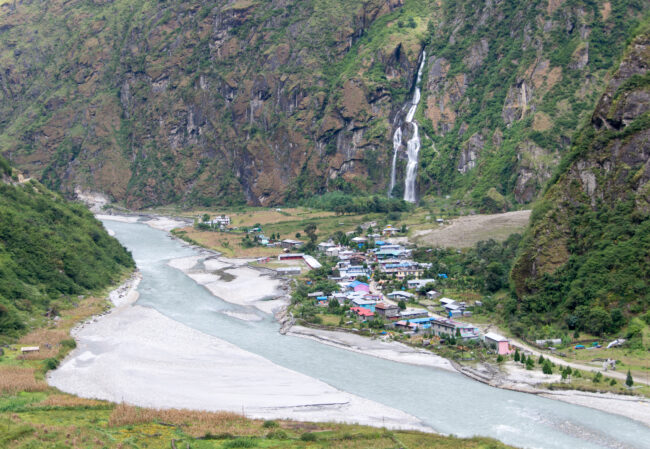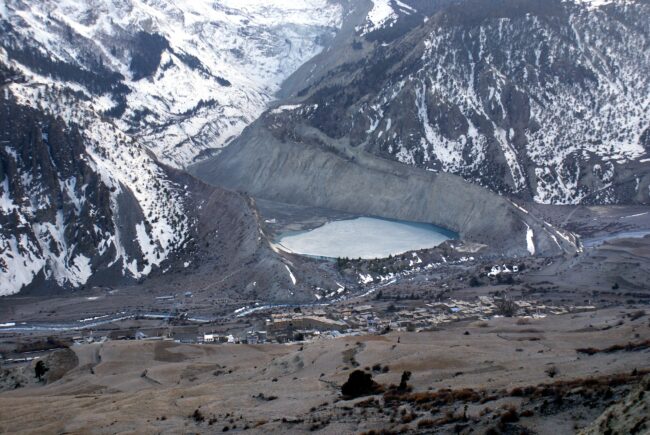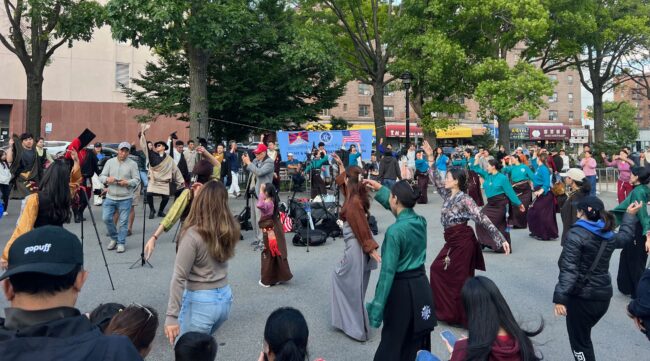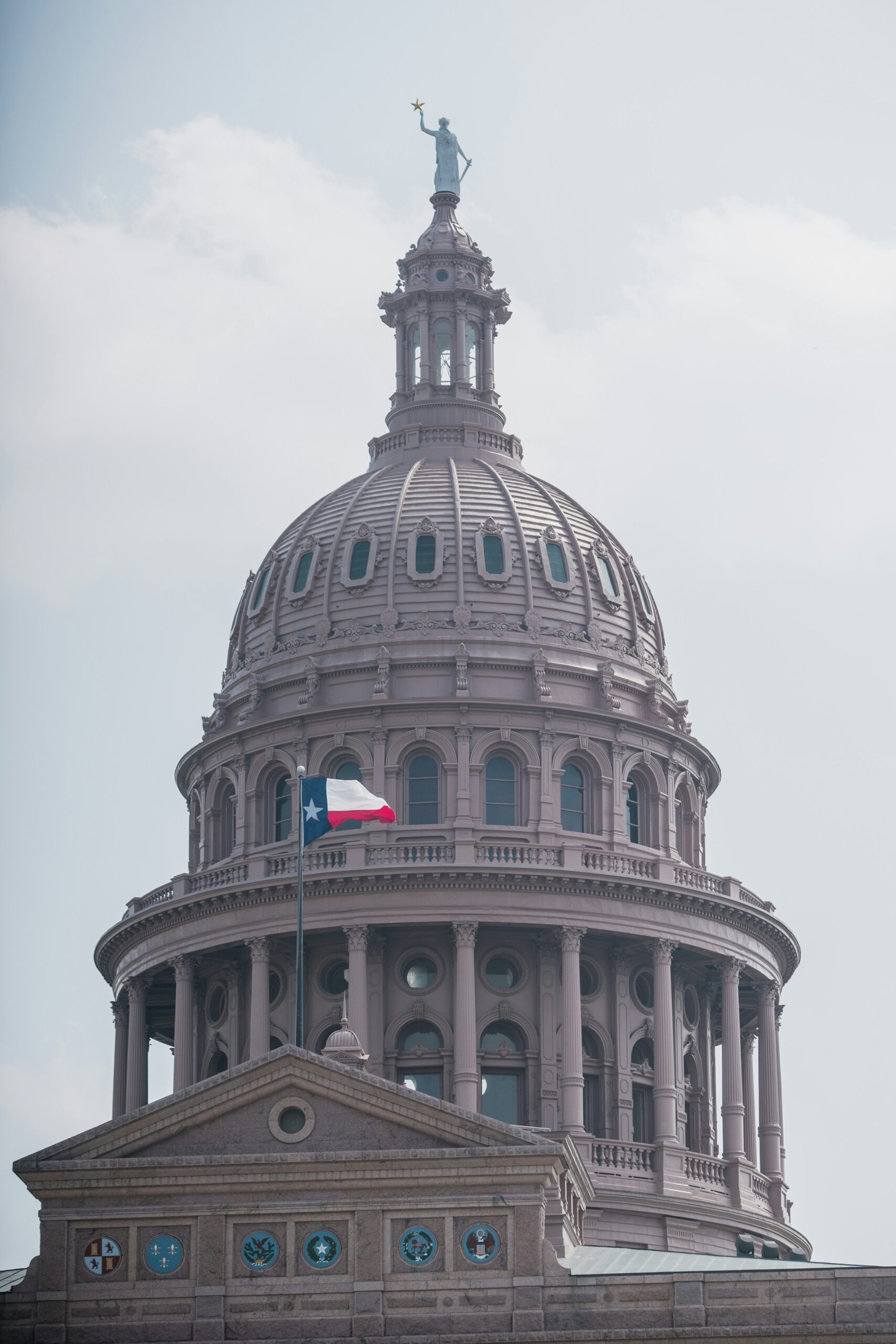PROTECT YOUR DNA WITH QUANTUM TECHNOLOGY
Orgo-Life the new way to the future Advertising by AdpathwayIn July 2025, glacial lake outburst floods on the border of Tibet and Nepal, in the Rasuwa district, killed at least 11 people. Two years earlier, in August 2023, a flash flood in Mustang, a high-altitude region in Nepal, caused an estimated 7.4 million USD in damages. In June 2021, Upper Manang, another remote mountain region, recorded 469% of the average rainfall, triggering flooding that destroyed 59 houses.
Nepal’s high mountain communities, home to dozens of Indigenous languages and rich cultural traditions, are facing intensifying climate-related shocks. These disasters are increasing outmigration and placing many local languages and traditions at risk. One major hub of resettlement is New York City, where GlacierHub documents efforts by diasporic communities and academic researchers to preserve endangered cultural heritage.
 A village in Manang hit by the June 2021 flood. (Sergey Ashmarin / Creative Commons)
A village in Manang hit by the June 2021 flood. (Sergey Ashmarin / Creative Commons)These events form part of a broader pattern across the Hindu Kush Himalaya (HKH), a vast mountain region stretching across eight countries, which is highly exposed to climate change impacts. This level of exposure rests in part on the large number of glaciers in the region. As temperatures rise, glacial melting has accelerated by 65% from 2010 to 2019, compared with the prior decade. This has caused an increase in glacial run-off in some regions.
While some high mountain regions are experiencing a temporary increase in water availability, other regions are experiencing water scarcity. Climate change has impacted snowfall patterns and the timing of monsoons which, in combination with glacial melting, have altered the timing and distribution of water resources. An International Centre for Integrated Mountain Development (ICIMOD) report warns that these water disruptions “impose a serious threat to the livelihoods of people living in this region.”
The shift in water resources is both historically significant and widespread across the HKH. Researchers at the Lamont-Doherty Tree Ring Laboratory employ dendrochronology—the analysis of tree rings—to study changing water patterns in the HKH. One researcher, Hung Nguyen, studied tree rings dating back to 1637 near the Kabul River Basin, downstream in another part of the HKH. Speaking of recent decades, he told GlacierHub that “dry years are getting drier,” and “wet years are getting wetter… because of the intensifying water cycle, we should expect both droughts and floods to become more severe.”
As climate change threatens Nepal’s remote communities, it also deepens existing economic vulnerabilities, particularly for households reliant on subsistence agriculture. Climate shocks have reduced agricultural output and, in some cases, displaced entire communities. Yet, as Alex de Sherbinin, a climate migration expert at the Columbia Climate School, said, the connection is rarely made explicit. “Migrants seldom cite climate change or climate impacts as factors [for migrating],” he noted.
Instead, it is economic pressures, exacerbated by climate-related disruptions, that drive migration. Together, these intertwined climate and economic forces have accelerated emigration across the HKH. In Nepal, it has tripled since the 1980s.
High Mountain Regions and Linguistic Diversity
An often overlooked aspect of emigration is its impact on linguistic diversity. The same geographic features that make villages in Manang, Mustang and other high mountain regions in the HKH vulnerable to climate change—remoteness, rugged terrain and isolation—have also fostered extraordinary linguistic diversity. According to Nepal’s 2012 Central Bureau of Statistics census, Manang is home to only 1,448 households. Among them, four distinct local languages are spoken.
These languages encode a wealth of ecological and cultural knowledge. “Languages are absolutely shaped by the physical environments where their speakers live,” explained Ross Perlin, a linguist at Columbia University.
 Glacier above village in Manang, Gangapurna Lake. (Bijaya Kumar Shrestha / Creative Commons)
Glacier above village in Manang, Gangapurna Lake. (Bijaya Kumar Shrestha / Creative Commons)One vivid example of this is the word “glacier.” In 1741, the British explorer William Windham travelled to the French Alps with local guides who spoke a dialect of Franco-Provençal (a Romance language related to French) called Savoyard. Where Windham saw “an ice sheet,” the locals had a more specific and useful word: “glacier.” Through Windham’s writings, the word entered English and became widely adopted in scientific discourse. Yet while the term has since gained global prominence to describe a “river of ice in a high mountain valley” the Savoyard language and its broader family, Franco-Provençal, has nearly disappeared.
As speakers migrate from their ancestral homelands, their languages come under increasing pressure. “The farther the people are from those environments… the more the knowledge fades,” said Perlin. Migrants often prioritize learning English or other dominant host-country languages, leading to a gradual decline in fluency in their native languages. In regions with small speaker populations, such as Manang, migration poses a serious threat to the survival of local languages.
Cultural Heritage Communities in New York
Fortunately, there are important efforts to counteract the cultural and linguistic losses that often accompany emigration. One important center of activity is New York, a major destination for migrants from Nepal and other high mountain regions. Nepalese immigration to the U.S. has increased substantially in the 21st century. Between 1988 and 2001, annual admissions to the U.S. from Nepal never exceeded 1,000 people per year. From 2011 to 2019, it was above 10,000. A sufficient number of migrants have come together to form cohesive ethnic communities, creating spaces where cultural and linguistic traditions can be maintained and evolve.
 A Tibetan association leads a traditional dance in Jackson Heights, Queens, New York. (Courtesy of Joseph Griffiths)
A Tibetan association leads a traditional dance in Jackson Heights, Queens, New York. (Courtesy of Joseph Griffiths) Perlin has worked to connect and support linguistic communities in New York through the Endangered Language Alliance (ELA), which he co-founded in 2010 with Daniel Kaufman, a linguist at Queens College, CUNY. The ELA records, documents and helps preserve endangered languages in their places of origin and in New York City. The ELA has created a remarkable interactive language map of the city. Perlin explores the journey of endangered language speakers in his recent book “Language City,” which follows several individuals navigating migration and acclimation to life in New York.
Diasporic communities in New York are at the forefront of preserving their cultural heritage. Rokesh Gurung, former president of Manang Samaj USA, a group representing the Nepalese community from Manang in the U.S., explained that the organization “teach[es] the youngsters the language, the dance.” It fosters community cohesion through cultural events, such as an annual archery festival. Beyond cultural preservation, the group also supports the Manang community in Nepal. After the devastating floods in June 2021, Gurung launched a fundraiser for the affected community.
As high mountain areas become increasingly inhospitable, dangerous and agriculturally unproductive, the displacement of communities is likely to accelerate. In this context, concerted efforts to preserve and promote threatened cultures and languages will only become more urgent.























 English (US) ·
English (US) ·  French (CA) ·
French (CA) ·